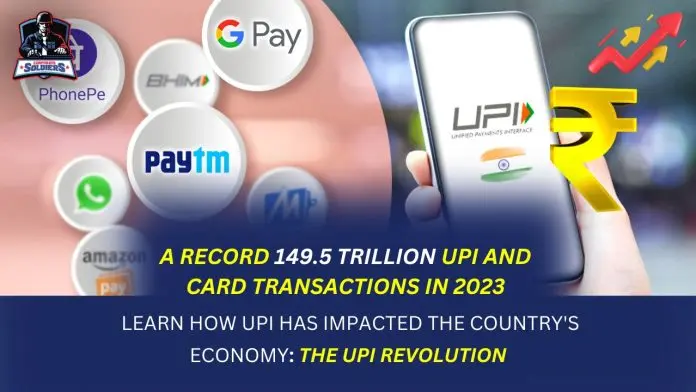In October 2023 Over 11 billion UPI transactions were recorded
With its profound effects on the Indian economy, the Unified Payments Interface (UPI) has become a game-changer in the financial sector. UPI, which was introduced by the National Payments Corporation of India (NPCI) in April 2016, has helped to decrease the amount of cash-based transactions in India, promote financial inclusion, and streamline digital transactions. With the help of actual statistics, we shall examine how UPI has impacted the Indian economy in this piece.
UPI accounted for 50% of total digital payment transactions in India
The quick rise of digital payments is one of UPI’s most important effects on the Indian economy. UPI only logged 93,000 transactions in August of 2016. In 2022, UPI completed more than 4.35 billion transactions in a single month. The expediency and uncomplicated nature of the UPI platform are responsible for this remarkable expansion.
UPI has brought millions of unbanked and underbanked individuals into the formal banking system
In India, UPI has been essential to the advancement of financial inclusion. It makes it possible for people who don’t have access to traditional banking services to take part in the digital economy. In August 2022, there were nearly 3.48 billion UPI transactions, compared to 42,256 in August 2016 (NPCI data). This shows that millions of people who are underbanked and without a bank account have managed to find a way.
UPI transactions reached 83.75 billion, demonstrating remarkable growth
There are many financial advantages to the decrease in cash transactions that UPI has contributed to. The Reserve Bank of India reports that in 2021, the share of GDP attributed to cash in circulation fell from 11.6% in 2016 to 9.2%. This decrease represents a move toward a less cash-dependent economy, which will result in lower expenses for printing and upkeep as well as less black money.
UPI accounted for 54% of e-commerce payments in India
The Indian retail and e-commerce industries have benefited immensely from the rise of UPI. Customers now find that making purchases online is safer and easier with the advent of UPI-based payment apps. Significant increases in UPI transactions have been reported by Amazon, Flipkart, and other e-commerce behemoths. The Economic Times reports that over 2 billion UPI transactions took place on e-commerce platforms in 2021, demonstrating the significant influence of UPI on online buying.
Initiatives for Financial Inclusion and Literacy
The government and financial institutions have started initiatives and programs to support financial inclusion and literacy. UPI is becoming a crucial instrument for these campaigns. For instance, UPI is used for direct benefit transfers in the Jan Dhan Yojana program, which attempts to provide financial services to every household. Since its launch, the program has opened nearly 43 crore (430 million) bank accounts, according to official data.
UPI’s instant payments yielded an additional $12.6 billion in cost savings in 2021
The growth in the use of digital payments, mostly through UPI, has benefited India’s GDP. The Indian market for digital payments is anticipated to reach more than $500 billion by 2023, greatly boosting the country’s economy, according to a report by the Boston Consulting Group. A number of industries, including financial services, transportation, and e-commerce, are responsible for this increase.
COVID-19 and UPI
UPI was essential in enabling contactless transactions and lowering the possibility of viral transmission through physical cash during the COVID-19 epidemic. UPI transactions increased as a result of people adopting digital payments as a safer option. During the pandemic, the switch to digital payments not only boosted economic activity but also sped up the uptake of digital financial services.
UPI processed over 139 lakh crore worth of transactions, accounting for 50% of India’s total digital payment volume
Unquestionably, the Unified Payments Interface (UPI) has had a significant impact on the Indian economy in a number of ways. Its rapid expansion, initiatives to promote financial inclusion, decline in cash transactions, encouragement of entrepreneurship, and support for a range of industries have all played a significant role in making India a more digitally-driven economy. In addition to making payments easier, UPI has increased accessibility, security, and transparency in the banking industry. UPI continues to lead this revolutionary journey as India moves closer to becoming a digital-first economy.

